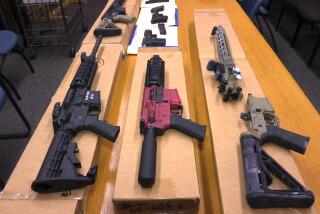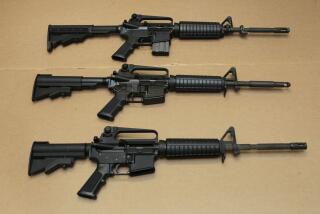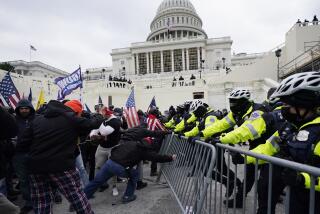Guns, yes and no
Presented with two historically plausible arguments about whether the 2nd Amendment secures an individual right to keep and bear arms, the Supreme Court on Thursday opted for the interpretation less suited to a 21st century America bedeviled by gun crime. That’s the disappointing part of the court’s long-awaited ruling striking down the District of Columbia’s strict gun-control ordinance. Fortunately, even though the decision endorses the individual-right explanation, it may have limited impact.
Gun-rights advocates will focus on what they will see as the magic words in Justice Antonin Scalia’s opinion for a 5-4 majority: “There seems to us no doubt, on the basis of both text and history, that the 2nd Amendment conferred an individual right to keep and bear arms.” Though a bit wordy for a bumper sticker, in isolation it could have been composed by the National Rifle Assn.
But Scalia immediately added this qualification: “Of course the right was not unlimited, just as the 1st Amendment’s right of free speech was not.” Elsewhere, Scalia explicitly cited gun-control laws not affected by this ruling, including those prohibiting felons and the mentally ill from possessing firearms, banning guns from schools and other “sensitive places” and, most important, regulating the sale of guns. Finally, Scalia’s definition of weapons protected by the amendment -- those in common use “for lawful purposes like self-defense” -- would seem to exclude Uzis and machine guns. (This ruling thus does not provide an excuse for Congress not to reenact a federal ban on assault weapons.)
None of this changes the fact that the majority -- including Chief Justice John G. Roberts Jr., who pledged fealty to precedent at his confirmation -- has upended an interpretation of the 2nd Amendment that has been the majority view for more than half a century: that the amendment’s reference to “a well-regulated” militia limits the right to keep and bear arms to organized military units such as the National Guard.
In his dissent, in which he tellingly traded historical -- and linguistic -- arguments with Scalia, Justice John Paul Stevens offered a spirited defense of the traditional view, one we wish the majority had embraced. But it is a fact that legal historians, some of them supporters of gun control as a matter of policy, increasingly have argued that the 2nd Amendment protects an individual right. (For that reason, some of them have advocated repeal of the amendment -- an undesirable option because it would open up the entire Bill of Rights to revision.)
It was probably inevitable that the court would revisit this issue. The district’s ordinance, which banned handguns and made it impossible for law-abiding citizens to keep working firearms in their homes, provided an unusually tempting target for justices who wanted to reconsider a constitutional issue that had been absent from their docket for almost 70 years. Thursday’s decision needlessly complicated the lives of legislators seeking to bring gun violence under control. But it could have been worse.


